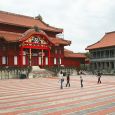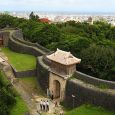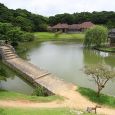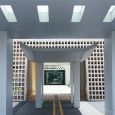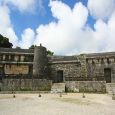Naha
Advertisement
By air
Naha Airport is the largest airport in the Okinawa area and the main hub for international and inter-island flights. A new monorail, opened in 2003, connects the airport to the city center.
Note: There is also a Naha Airport (NAH) in Indonesia, which should not be confused with this!
By train
The Okinawa Monorail, also known as the Yui Rail carries passengers from Naha Airport Station to the center of Naha, Kokusai-dori, Shintoshin, and to the terminal at Shuri Station, near Shuri Castle.
Advertisement
Shuri Castle
A city district of Naha today, Shuri is the name of the former capital of the Ryukyu Kingdom. Shuri Castle (Shurijo) served as the administrative center and residence of the Ryukyu kings for several centuries until Okinawa became a Japanese prefecture in 1879. The castle is included as one of the UNESCO World Heritage designated Castles of the Ryukyu Kingdom sites.
Shuri Castle was originally built in the late 1300s, and played an integral role in the political unification of the island. Wars and fires destroyed the castle multiple times over the centuries, most recently in the Battle of Okinawa in 1945. The current buildings are beautiful reconstructions dating from 1992. The approach to the castle's central buildings leads through multiple gates, including the well known Shureimon Gate. The castle's hilltop location allows for nice views over Naha along the way.
Shikinaen Garden
Shikinaen was constructed in the end of the 18th century as the second residence of the Ryukyu kings. It features beautiful, relatively simple, wooden palace buildings with Okinawan style, red tile roofs and a spacious Japanese style landscape garden with a central pond. While the garden is designed in a style seen elsewhere in Japan, the architecture and flora give Shikinaen a uniquely Okinawan flavor.
Shikinaen was completely destroyed in the Battle of Okinawa of 1945, but has been neatly restored in the postwar years. In 2000, Shikinaen was among the sites added to the list of UNESCO World Heritage Sites under the title Gusuku Sites and Related Properties of the Kingdom of Ryukyu.
Himeyuri Peace Museum
Students from two women's schools, together called Himeyuri, were mobilized to work as field nurses during the Battle of Okinawa in 1945. This memorial museum documents, from a personal perspective, their lives before and during the battle, in which many of them died. Exhibits are labeled in English, and the museum is a worthwhile visit. ¥300 for adults
Tamaudun Mausoleum
The Tamaudun Mausoleum was built around the beginning of the 16th century as the mausoleum for the royal family of the Ryukyu Kingdom. It was restored after suffering extensive damage during the war. The mausoleum is located only a short walk from Shuri Castle, and is also included as one of the UNESCO World Heritage designated Castles of the Ryukyu Kingdom and Related Sites.
The mausoleum consists of three closed chambers The left one for kings and queens, the right one for princes and princesses, and the central one for storing recently deceased bodies before undergoing a ritual of bone cleaning a few years later. The mausoleum follows the Okinawan burial tradition of constructing large stone tombs, but it was built in a particularly grand style to exalt the royal family.
Okinawa Prefectural Museum
The Okinawa Prefectural Museum is a great place to learn more about Okinawa's unique history and culture. The museum was previously located near Shuri Castle, but was relocated and reopend in a modern building in 2007. It consists of two separate museums: a history museum and an art museum.
The history museum covers the entire history of Okinawa from before the time of the Ryukyu Kingdom to modern times. The scope of the museum is wide and includes natural history, folklore, crafts and archaeology. There is a great deal of well presented information about Okinawan culture and history which visitors could spend a few hours exploring.
The art museum is a bit smaller than the history museum and features a variety of art forms in multiple galleries, including sculptures, paintings, sketches and videos. The museum's collection focuses on local artists and themes, and the works on display are generally modern or contemporary. There is also space for special exhibitions, which come with separate admission fees.
March - July
October - December
Information not available
Advertisement

